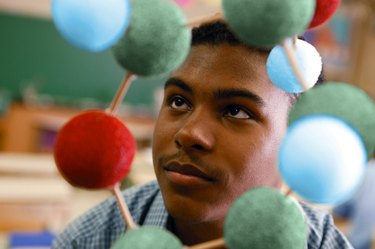Things You'll Need
1-inch Styrofoam craft balls
1.5-inch Styrofoam craft balls
3 shades of acrylic or craft paint
Paintbrushes
Wire banana hanger
Glue gun
Craft rings, varying sizes
Wire cutters
Clear thread
Clear tape
Pencil
Paper

Make a 3D model of any element atom. The atom model can be used to teach students about the structure of elements; and it is a suitable project for students learning the basics of chemistry. While preparing the element atom model, students can learn about the element, protons, neutrons, electrons and energy levels. The models are created using simple crafting supplies and the technique can be applied to any element on the Periodic Table.
Step 1
Research the element that you will use to create the model. To build the model, you will need to know the number of neutrons, protons and electrons in the atom. Also, refer to an electron configuration table for the number of electrons in each of the atom's energy levels.
Video of the Day
Step 2
Draw a model of the atom. Draw a center circle for the nucleus and fill it with the appropriate number of protons and neutrons for your element. Draw circles around the nucleus to represent the number of energy levels for the atom, then fill them with the appropriate number of electrons by drawing smaller circles along the rings.
Step 3
Assign a color to the neutrons, protons, and electrons. Paint the 1.5-inch Styrofoam balls in the colors selected for the protons and neutrons. Paint the one inch balls in the color selected for the electrons. Allow the painted balls to dry completely.
Step 4
Use the glue gun to glue the protons and neutrons together into the nucleus. Alternate between colors so that the protons and neutrons are connected in an alternating pattern. Set the piece aside and allow it to dry.
Step 5
Measure the wire rings against the nucleus. The first ring should be large enough to allow for a one inch space between the nucleus and the ring. Increase the ring size for each new energy level. Cut the wire rings to create an opening in each ring. Gently pull the ring apart to create a one inch gap in the cut.
Step 6
Thread the electrons onto the rings, following the number of electrons per energy level outlined by the electron configuration table. The electrons should be arranged on each end of the ring, at the top, bottom, left and right sides. Use the glue gun to close the cut made in the rings.
Step 7
Cut the clear thread into an 18 inch piece. Take the largest ring and tie the thread at its top end, allowing for the remainder of the thread to hang down into the ring. Secure the knot in the thread. Measure one inch down the thread and tie the next ring onto it. Continue measuring and attaching rings to the thread until all of the energy levels have been attached.
Step 8
Measure two inches down on your thread and cut the remaining string. Measure one inch on the string and mark that point. Attach the thread at the point you marked to the center of the nucleus, attaching the thread to the nucleus with clear tape. Cut any remaining thread hanging from the nucleus.
Step 9
Hang the atom from the banana hanger by its largest ring. Use a dab of hot glue to secure the rings to the banana hanger.
Tip
If no banana hanger is available, the atom model can be attached to an S-hook and hung to display.
Label the atom and its protons, neutrons and electrons.
Use a permanent marker to label the charges on the protons and electrons.
Video of the Day